Heat and Heat Technology
Heat is a form of energy that can be transferred from one object to another. It is a crucial concept in science and plays a significant role in various technological applications.
Key Concepts
- Temperature: A measure of the average kinetic energy of the particles in a substance. It determines the direction of heat transfer - from hot to cold.
- Heat Transfer: The movement of heat from a warmer object to a cooler object. There are three main methods of heat transfer: conduction, convection, and radiation.
- Thermal Expansion: The tendency of matter to change in shape, area, and volume in response to a change in temperature.
- Specific Heat: The amount of heat required to raise the temperature of a unit mass of a substance by one degree Celsius.
- Heat Technology: The application of scientific principles for practical purposes related to the transfer, storage, and use of heat.
Study Guide
To understand the concepts of heat and heat technology, it's important to focus on the following key points:
1. Temperature and Heat Transfer
- Define temperature and explain how it relates to the kinetic energy of particles. Understand the concept of thermal equilibrium.
- Describe the three main methods of heat transfer - conduction, convection, and radiation. Provide examples of each method.
2. Thermal Expansion and Specific Heat
- Discuss the phenomenon of thermal expansion and its practical implications in everyday life and engineering applications.
- Explain the concept of specific heat and its significance in determining the heat capacity of different substances.
3. Heat Technology Applications
- Explore the practical applications of heat technology in various fields such as heating, cooling, and energy production.
- Discuss the importance of heat transfer in the design of thermal insulators, HVAC systems, and renewable energy technologies.
Additional Resources
For further study, you can refer to textbooks, online resources, and interactive simulations related to heat and heat technology.
.◂Science Worksheets and Study Guides Eighth Grade. Heat and heat technology
Study Guide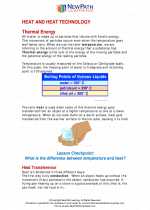 Heat and heat technology
Heat and heat technology  Worksheet/Answer key
Worksheet/Answer key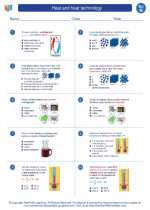 Heat and heat technology
Heat and heat technology  Worksheet/Answer key
Worksheet/Answer key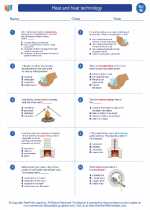 Heat and heat technology
Heat and heat technology  Worksheet/Answer key
Worksheet/Answer key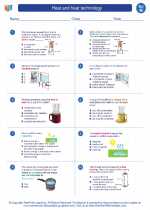 Heat and heat technology
Heat and heat technology  Vocabulary/Answer key
Vocabulary/Answer key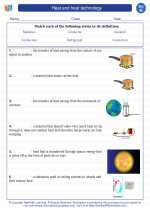 Heat and heat technology
Heat and heat technology 

 Worksheet/Answer key
Worksheet/Answer key
 Worksheet/Answer key
Worksheet/Answer key
 Worksheet/Answer key
Worksheet/Answer key
 Vocabulary/Answer key
Vocabulary/Answer key

The resources above cover the following skills:
Physics: Students will use scientific skills and processes to explain the interactions of matter and energy and the energy transformations that occur.
Thermodynamics: Describe and cite evidence that heat can be transferred by conduction, convection and radiation.
Based on observable phenomena, identify and describe examples of heat being transferred through conduction and through convection.
Based on observable phenomena, identify examples to illustrate that radiation does not require matter to transfer heat energy.
Research and identify the types of insulators that best reduce heat loss through conduction, convection, or radiation.